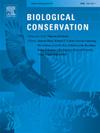猩猩种群监测方法:优势、挑战和机遇
IF 4.4
1区 环境科学与生态学
Q1 BIODIVERSITY CONSERVATION
引用次数: 0
摘要
在过去的几十年里,猩猩的数量一直在迅速下降。人口状况的代理范围从简单的存在/缺失数据到绝对密度估计。监测方法多种多样,包括人类观测、相机捕获、声学监测和航空调查。这篇定性综述提供了人口监测方法和相关指标的全面概述,讨论了它们的优势、挑战和机遇。基于地面的巢穴调查被广泛用于密度估计,但成本高,调查范围有限,并且依赖于具有挑战性的巢穴参数,如衰减率。基于访谈的方法和公民科学方法可以提供长期有效的数据收集手段,但由于人为偏见,它们提供的人口指标不太详细。遗传分析可以提供准确的人口估计,但受到难以获得足够样本量的限制。相机陷阱也面临着类似的低捕获率挑战。声学监测对于检测存在和不存在是有效的,但对于密度估计的用途有限,因为只有一小部分人口产生长距离传播的发声。直升机可以快速调查大片和偏远地区的巢穴,但运营成本很高。新兴技术,包括光学无人机的自动巢探测和热无人机的直接观测,可以提供具有成本效益的监测选择,但通常在法律上受到短飞行距离的限制。展望未来,高分辨率的卫星图像可能有望克服许多后勤挑战,但目前在猩猩监测方面仍不发达。本文章由计算机程序翻译,如有差异,请以英文原文为准。
Orangutan population monitoring methods: Strengths, challenges, and opportunities
Orangutan population sizes have been declining rapidly during the past decades. Proxies for the status of populations range from simple presence/absence data to estimations of absolute density. A variety of monitoring methods are available, including human observations, camera trapping, acoustic monitoring and aerial surveys. This qualitative review provides a comprehensive overview of population monitoring methods and associated metrics, discussing their strengths, challenges and opportunities.
Ground-based nest surveys are widely used and effective for density estimations but are costly, have a limited survey range, and rely on challenging nest parameters such as decay rates. Interview-based and citizen science methods can offer the means for long-term cost-effective data collection, but they provide less detailed population metrics due to human bias. Genetic analyses can present accurate population estimates but are constrained by difficulties in obtaining sufficient sample sizes. Camera traps face similar challenges with low capture rates. Acoustic monitoring is effective for detecting presence and absence but has limited use for density estimation, as only a subset of the population produces vocalizations that carry over long distances. Helicopters can rapidly survey large and remote areas for nests, but come with high operational costs. Emerging technologies, including automated nest detection with optical drones and direct observations with thermal drones, could offer cost-effective monitoring options but are often legally constrained to short flight ranges. Looking forward, very high-resolution satellite imagery may hold promise for overcoming many logistical challenges but currently remains underdeveloped for orangutan monitoring.
求助全文
通过发布文献求助,成功后即可免费获取论文全文。
去求助
来源期刊

Biological Conservation
环境科学-环境科学
CiteScore
10.20
自引率
3.40%
发文量
295
审稿时长
61 days
期刊介绍:
Biological Conservation is an international leading journal in the discipline of conservation biology. The journal publishes articles spanning a diverse range of fields that contribute to the biological, sociological, and economic dimensions of conservation and natural resource management. The primary aim of Biological Conservation is the publication of high-quality papers that advance the science and practice of conservation, or which demonstrate the application of conservation principles for natural resource management and policy. Therefore it will be of interest to a broad international readership.
 求助内容:
求助内容: 应助结果提醒方式:
应助结果提醒方式:


